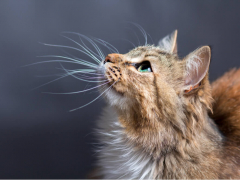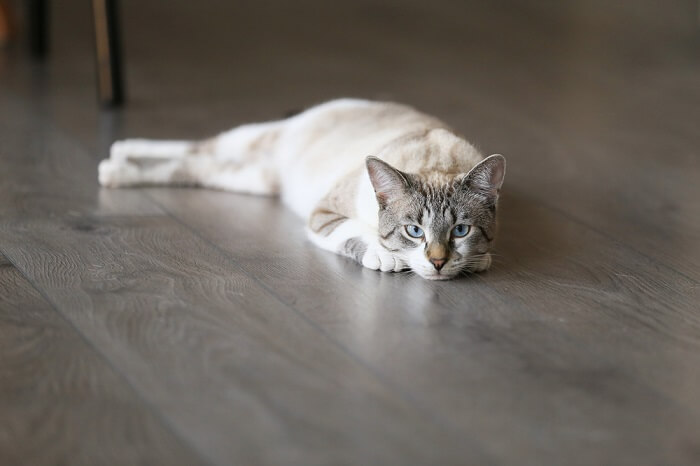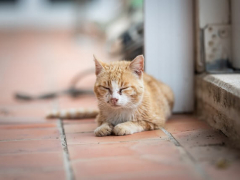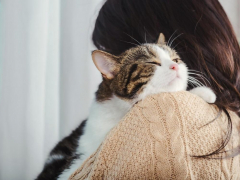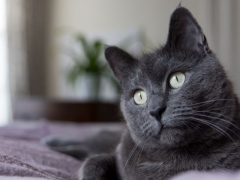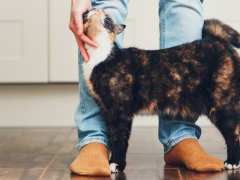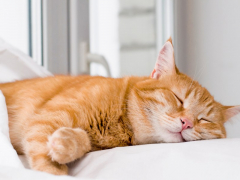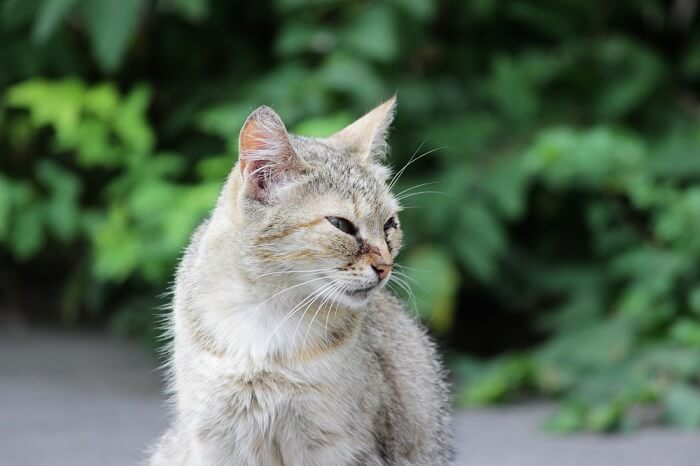
Feline herpesvirus type 1 (FHV-1) is a very common viral infection in cats that causes upper respiratory infections (feline viral rhinotracheitis; FVR) and ocular diseases like conjunctivitis. FHV-1 infection is the most common cause of ocular problems in cats and kittens.
The initial infection most often develops in kittens around 8-12 weeks of age, and then most cats (estimated 80%) become carriers of the virus. The dormant virus will flare up in response to stressors, leading to recurrent symptoms over the cat’s lifetime.
How Does a Cat Become Infected With Feline Herpesvirus?
Cats become infected with FHV-1 through contact with saliva, ocular secretions, and nasal secretions from an infected cat. Most of the time, kittens contract the virus from their mother prior to weaning, but it also is common in shelters and catteries as it is highly contagious.
After recovery from the primary infection, the virus often becomes dormant within nerves and the cat becomes a latent carrier. This means the virus remains in an inactive form but becomes reactivated to cause symptoms in response to stress, steroid use (topical and systemic), or other illnesses.
These “flare-ups” are called recrudescent diseases and can cause eye diseases, upper respiratory symptoms, or both. Respiratory symptoms include sneezing attacks, congestion, and nasal discharge. These symptomatic cats are contagious and actively shed the virus during these flare-ups.
The standard core vaccines given to cats include a vaccine against FHV-1. While the vaccine won’t prevent respiratory or eye diseases from FHV-1, it will lessen the severity and length of illness. The vaccine requires booster doses as the immunity is not life-long and won’t protect fully against a high dose of virus exposure.
What Are the Eye Diseases Seen With FHV-1 Infection?
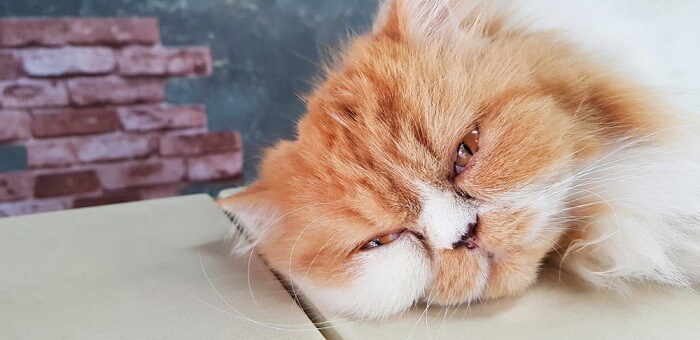
Conjunctivitis is the most common ocular condition caused by feline herpesvirus type 1.
Conjunctivitis is the most common ocular condition caused by FHV-1. Kittens with FHV-1 infections often have severe conjunctivitis in both eyes along with respiratory tract infections.
They may become systemically ill with fever and decreased appetites, and may require supportive care. Adult cats who experience flare-ups of the FHV-1 virus may only have symptoms in one eye and often lack respiratory symptoms.
Symptoms of conjunctivitis include:
- Squinting
- Swelling and redness of the eye membranes (conjunctiva)
- Elevated third eyelid
- Ocular discharge (often tan colored and pus-like)
Corneal ulceration is the second most common ocular condition seen with FHV-1. Corneal ulcers can develop bacterial infections, which can become severe enough to cause significant scarring or even rupture of the cornea.
Symptoms of corneal ulcers are like conjunctivitis, but also include:
- Haze or cloudiness to the cornea (clear window of the eye)
- A dent or divot in the cornea
- Redness to the cornea
Other less common eye conditions associated with FHV-1 include keratitis, eosinophilic keratitis, corneal sequestrum, and keratoconjunctivitis sicca (dry eye).
How Is an FHV-1 Infection Diagnosed?
Because FHV-1 is so common, testing is not often necessary if the cat is showing the common clinical signs.
Testing methods are available through professional laboratories using samples from the eyes or nose and include virus isolation, fluorescent antibody (FA) testing, serology such as ELISA or serum neutralizing titers, and polymerase chain reaction (PCR) testing. It is important to know that these tests can have false negative results.
A complete ophthalmic examination should be performed in cats exhibiting FHV-1 symptoms and include a fluorescein stain to check for corneal ulcers. Severe conditions may benefit from referral to a veterinary ophthalmologist.
What Is the Treatment For FHV-1 Eye Diseases?
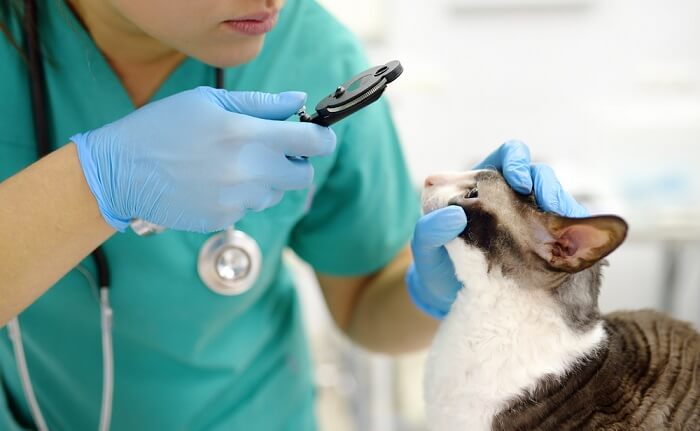
Testing is often not necessary if the cat is showing the clinical signs of FHV-1 eye disease.
Treatment of FHV-1 can include symptomatic and supportive care, topical antivirals, oral antivirals, and topical and oral antibiotics. Nutritional support, hydration, and environmental cleanliness are important for kittens suffering from FHV-1 initial infection.
Antiviral medications are appropriate for both initial infections and flare-ups and have been shown to be safe and effective. Common choices are famciclovir (Famvir®) oral tabs and cidofovir topical antiviral drops.
Antibiotics should be used if a secondary bacterial infection is suspected, and your vet may prescribe eye medications and/or systemic antibiotics. Corneal ulcers with severe bacterial infections can require antibiotic eye drops every 1-2 hours to save the eye.
In severe cases, antiviral medication may be used. Antiviral eyedrops are used for herpes virus-induced ulcers.Supplementation with the amino acid L-lysine has shown to reduce shedding and recurrence of chronic flare-ups.
Home Remedies
Keeping a cat ill with congestion in a steamy bathroom for 15-20 minutes to loosen congestion. Warming up food in the microwave to release aroma, if sense of smell and taste are reduced. Using a warm, damp washcloth to gently remove ocular and nasal discharge.
Also Read: 11 Signs That You Need to Get Your Cat To the Emergency Room
Frequently Asked Questions
How do cats get herpes in the eye?
Cats become infected with FHV-1 through contact with saliva, eye secretions, and nasal secretions from an infected cat. Kittens most often contract the virus from their mom around 8-12 weeks of age, but it is also very common in shelters and catteries. The virus causes upper respiratory disease and eye conditions like conjunctivitis.
Is feline ocular herpesvirus contagious?
Feline herpes virus -1 (FHV-1) is highly contagious to cats who have not been exposed to the virus before, such as young kittens or unvaccinated adult cats. The feline herpes virus only infects domestic and wild cats and is not contagious to other species like dogs or humans.
Can feline herpes be cured?
Once a kitten or cat becomes infected with FHV-1, they will usually become life-long carriers of the virus. About 80% of cats develop the dormant virus, which will flare up in response to stressors, such as illness, steroid use, or pregnancy. These flare ups cause recurrent symptoms over the cat’s lifetime.
-
Stiles, J, Reinstein, SL. Feline Herpesvirus Ophthalmic Diseases. In: Reinstein SL, ed. Guide to Clinical Ophthalmology. 1st ed. NAVC Media; 2019:93-106.
-
Stiles J. Feline ophthalmology. In: Gelatt KN, Gilger BC, Kern TJ, eds. Veterinary Ophthalmology. 5th Ed. Hoboken, NJ: Wiley-Blackwell; 2013:1477-1559.
